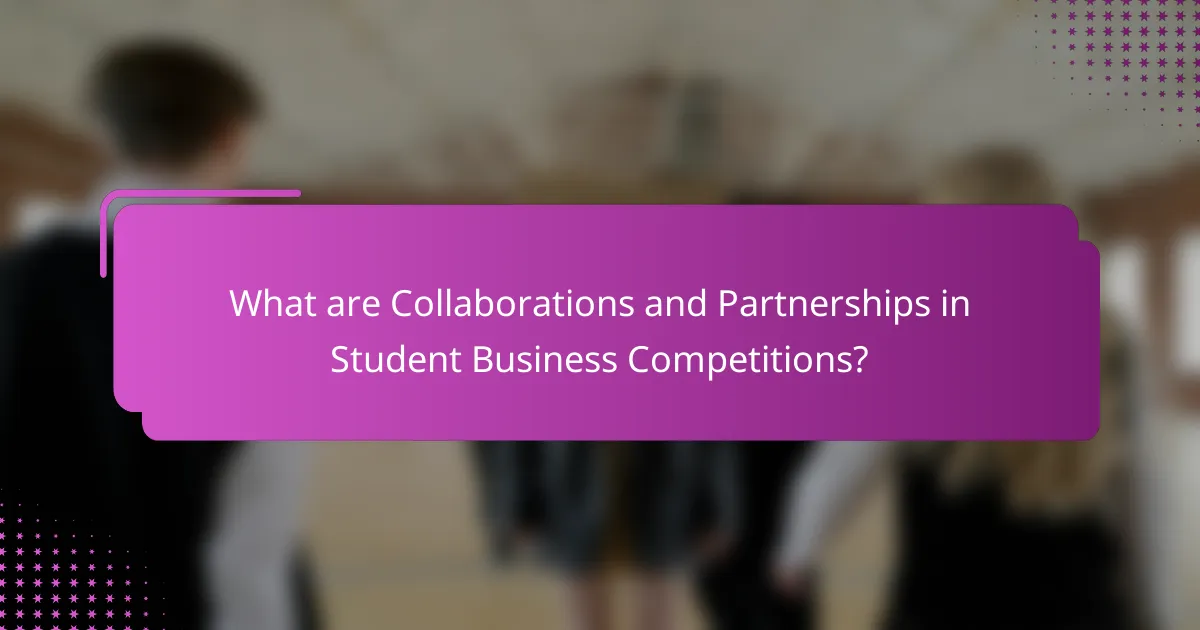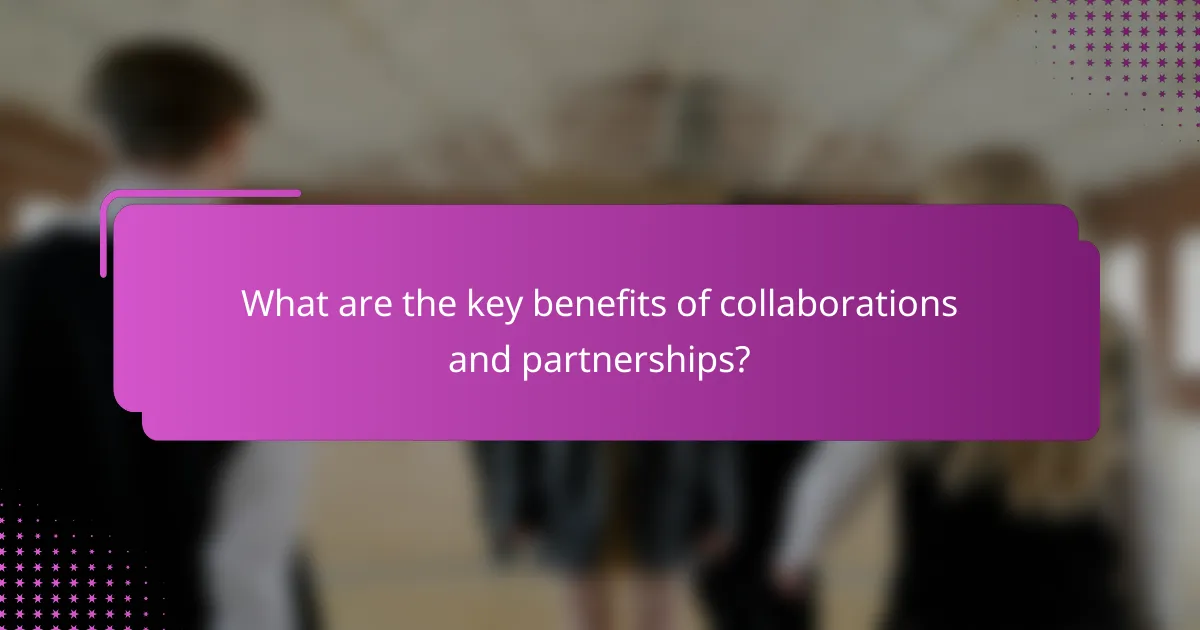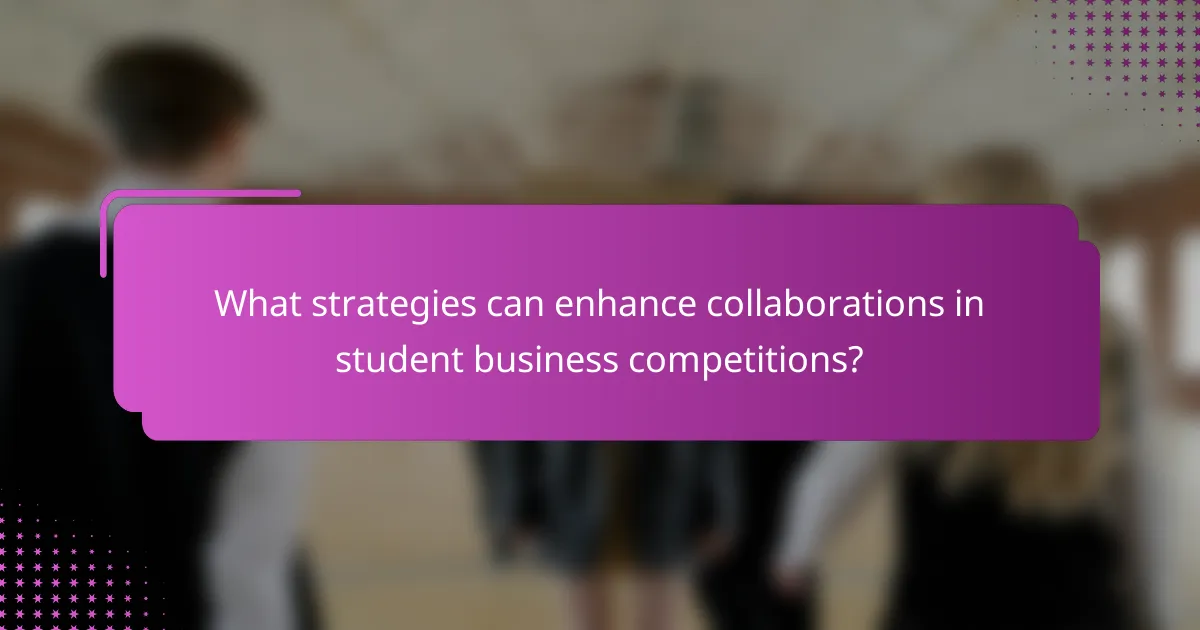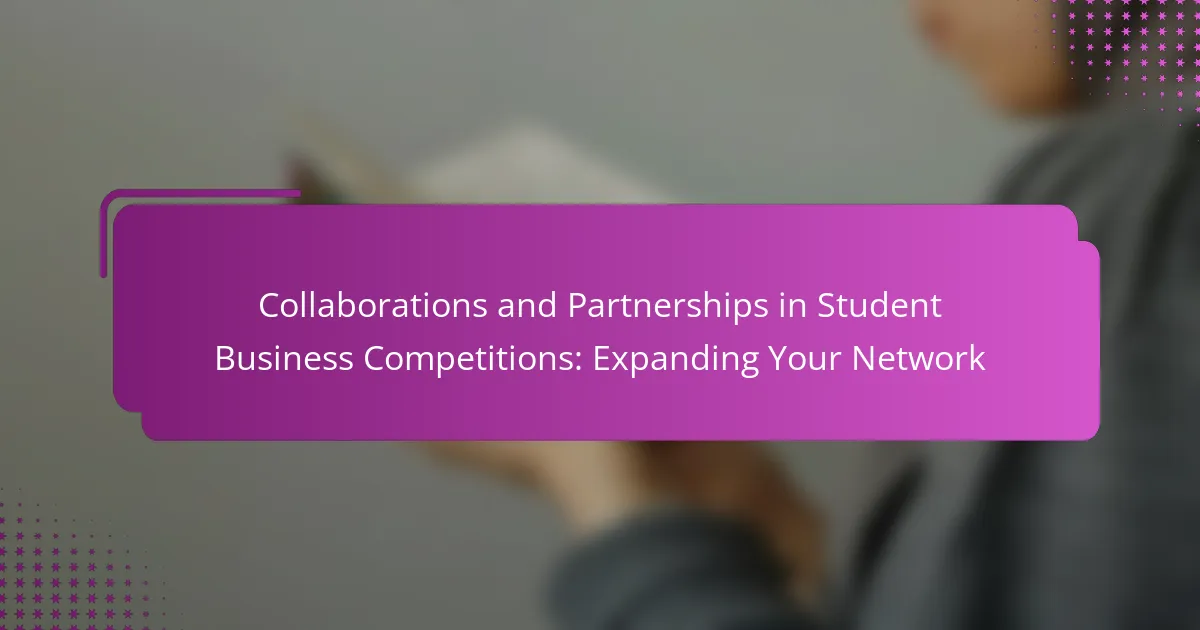Collaborations and partnerships in student business competitions involve alliances between students, organizations, and institutions aimed at enhancing participation and outcomes. These collaborations leverage diverse skills and resources, facilitating knowledge sharing, networking opportunities, and mentorship. By pooling expertise, participants can create innovative solutions and improve project viability, while also gaining access to funding and industry insights. Effective communication and the use of collaboration tools are essential for fostering understanding and alignment among team members. Overall, successful partnerships can lead to increased competitiveness, visibility, and long-term opportunities for students in business competitions.

What are Collaborations and Partnerships in Student Business Competitions?
Collaborations and partnerships in student business competitions refer to the alliances formed between students, organizations, or institutions to enhance participation and outcomes. These collaborations can leverage diverse skills and resources. They often involve sharing knowledge, networking opportunities, and mentorship. Partnerships may include universities, businesses, and non-profits. Such alliances can provide access to funding, expertise, and industry insights. Collaborations can increase the competitiveness of participants. They also foster a supportive environment for innovation and creativity. Successful examples often lead to enhanced learning experiences and improved project viability.
How do collaborations enhance student business competitions?
Collaborations enhance student business competitions by fostering diverse skill sets and perspectives. When students team up, they combine their strengths, leading to innovative solutions. This diversity can improve problem-solving and creativity, essential in competitive environments. Collaborations also provide networking opportunities, connecting students with industry professionals and mentors. These connections can lead to internships and job placements after graduation. Additionally, working in teams helps students develop essential soft skills like communication and teamwork. Research shows that collaborative learning environments increase student engagement and motivation. Therefore, collaborations significantly enrich the overall experience in student business competitions.
What roles do partnerships play in competition success?
Partnerships play a crucial role in competition success by enhancing resource access and expertise. They allow participants to leverage each other’s strengths. Collaborating with experienced partners can provide valuable insights. This collaboration often leads to innovative solutions. Partnerships can also expand networks, opening doors to new opportunities. For instance, research shows that teams with diverse partnerships perform better. According to a study by the Harvard Business Review, collaboration can increase overall team performance by up to 40%. Thus, effective partnerships are essential for achieving success in competitions.
How can collaborations lead to innovative solutions?
Collaborations can lead to innovative solutions by combining diverse perspectives and expertise. When individuals from different backgrounds work together, they bring unique ideas and approaches. This diversity fosters creativity and encourages out-of-the-box thinking. Research shows that teams with varied skill sets are more effective at problem-solving. A study by the Harvard Business Review found that diverse teams outperform homogeneous ones in innovation. Collaborations also facilitate resource sharing, which can enhance research and development efforts. By pooling resources, teams can tackle larger challenges and create more impactful solutions.
Why are networking opportunities important in student competitions?
Networking opportunities are important in student competitions because they facilitate connections with industry professionals and peers. These connections can lead to mentorship, internships, and job opportunities. Engaging with professionals allows students to gain insights into their fields. It also enhances their understanding of industry trends and expectations. Furthermore, networking fosters collaboration on future projects. According to a study by the National Association of Colleges and Employers, 85% of jobs are filled through networking. This statistic underscores the significance of building professional relationships during competitions.
How do networking opportunities impact future career prospects?
Networking opportunities significantly enhance future career prospects. They provide access to industry professionals and mentors. Building relationships can lead to job referrals and insider information about openings. According to a LinkedIn survey, 85% of jobs are filled through networking. Networking also fosters collaboration and skill-sharing among peers. Engaging in networking events can increase visibility within a chosen field. This visibility often translates into greater career advancement opportunities. Networking helps individuals stay informed about industry trends and developments.
What types of networks can be built through collaborations?
Collaborations can build various types of networks, including professional networks, social networks, and knowledge networks. Professional networks connect individuals for career development and opportunities. Social networks facilitate relationships and community building among participants. Knowledge networks focus on sharing expertise and resources, enhancing learning and innovation. Each type of network serves distinct purposes and can lead to valuable partnerships. For example, professional networks often result in job placements and mentorship opportunities. Social networks can foster friendships and support systems. Knowledge networks can drive collaborative projects and research initiatives. These networks enhance the overall experience in student business competitions, leading to greater engagement and success.

What are the key benefits of collaborations and partnerships?
Collaborations and partnerships enhance resource sharing and expand networks. They allow participants to pool expertise and skills. This pooling leads to innovative solutions and improved outcomes. Collaborations can increase visibility and credibility in competitions. They often result in access to new markets and customer bases. Partnerships can also lead to cost savings through shared expenses. Successful collaborations can foster long-term relationships and future opportunities. Research shows that teams with diverse skills perform better in competitive environments.
How do collaborations improve resource access?
Collaborations improve resource access by pooling diverse assets and expertise. This synergy allows participants to share knowledge, skills, and tools. For example, in student business competitions, teams can leverage mentors’ guidance and industry connections. Collaborations also facilitate access to funding opportunities through joint proposals. Research shows that partnerships increase the likelihood of securing grants and sponsorships. According to a study by the National Association of Colleges and Employers, collaborative projects enhance students’ employability by providing real-world experience. Overall, collaborations foster a more resource-rich environment that benefits all parties involved.
What resources can be shared through partnerships?
Partnerships can share various resources, including knowledge, expertise, and financial support. Knowledge resources might involve sharing industry insights and best practices. Expertise can include mentorship from experienced professionals. Financial support can come in the form of sponsorships or grants. Additionally, partnerships can facilitate access to networks and connections that can benefit all parties involved. Collaborative tools and technology platforms may also be shared to enhance communication and project management. Shared marketing resources can help increase visibility and reach. These collaborative efforts often lead to enhanced innovation and improved outcomes for all partners.
How does resource sharing benefit competition outcomes?
Resource sharing enhances competition outcomes by fostering collaboration among participants. It allows teams to access diverse skills and knowledge. This collaboration can lead to innovative solutions and improved strategies. Shared resources can include mentorship, financial support, and technology. Studies show that teams leveraging shared resources often perform better. For instance, a report from the National Bureau of Economic Research indicates that collaborative efforts increase success rates in competitions. Additionally, resource sharing helps reduce costs and risks associated with competition. Consequently, it encourages more participants to engage in competitions, enriching the overall experience.
What skills can students develop through partnerships?
Students can develop various skills through partnerships. These skills include teamwork, communication, and problem-solving. Teamwork skills are enhanced as students collaborate on projects. Effective communication is vital for sharing ideas and feedback. Problem-solving skills improve through joint decision-making processes. Additionally, students gain leadership abilities by taking initiative within partnerships. Networking skills are also cultivated, which can benefit future career opportunities. Research indicates that students engaged in partnerships perform better academically and socially. These skills are crucial for success in both academic and professional settings.
How do collaborations enhance teamwork and communication skills?
Collaborations enhance teamwork and communication skills by fostering a shared goal among participants. When individuals work together, they learn to coordinate their efforts effectively. This process requires clear communication to express ideas and feedback. Team members develop active listening skills as they engage with diverse perspectives. Collaborations also create opportunities for conflict resolution, which strengthens interpersonal relationships. Research shows that teamwork in collaborative settings boosts problem-solving abilities. A study by Salas et al. (2015) found that effective communication is a critical factor in successful team performance. Overall, collaborations promote a culture of trust and support, essential for developing strong teamwork and communication skills.
What leadership skills can be gained from working in teams?
Working in teams develops several leadership skills. These skills include communication, conflict resolution, and decision-making. Effective communication is vital for conveying ideas and feedback. Team members learn to articulate their thoughts clearly and listen actively. Conflict resolution skills are honed as individuals navigate differing opinions. This experience fosters negotiation and compromise abilities. Decision-making skills improve through collaborative discussions and consensus-building. Teams often face time-sensitive decisions, enhancing critical thinking under pressure. These skills are essential in business environments, where teamwork is common. Research indicates that 70% of leadership effectiveness comes from interpersonal skills developed in team settings.

What strategies can enhance collaborations in student business competitions?
Establishing clear communication channels enhances collaborations in student business competitions. Effective communication fosters understanding and alignment among team members. Utilizing collaboration tools, such as Slack or Trello, can streamline project management. Regular meetings allow for updates and feedback, ensuring everyone is on the same page. Setting shared goals creates a unified vision for the team. Encouraging diverse perspectives can lead to innovative solutions. Building trust through team-building activities strengthens relationships among participants. Lastly, providing mentorship opportunities connects students with experienced professionals, enriching the collaborative experience.
How can students identify potential partners?
Students can identify potential partners by assessing shared interests and goals. They should engage in networking events related to their field. Participating in workshops and seminars can also provide opportunities to meet like-minded individuals. Utilizing social media platforms for professional networking is effective. Joining student organizations or clubs focused on business can facilitate connections. Attending competitions allows students to observe potential collaborators in action. Researching peers’ skills and experiences can help in finding complementary strengths. Building relationships through informal meetings can further enhance partnership opportunities.
What criteria should be used to evaluate potential collaborators?
Evaluate potential collaborators based on their expertise, reliability, and alignment with your goals. Expertise ensures they possess relevant skills and knowledge. Reliability indicates their commitment and ability to meet deadlines. Alignment with goals ensures shared vision and objectives. Assessing these criteria enhances collaboration effectiveness. Research shows that successful partnerships often stem from aligned values and complementary skills.
How can students approach potential partners effectively?
Students can approach potential partners effectively by being clear and confident in their communication. They should first research the partners’ interests and goals. This knowledge allows for tailored conversations that resonate with the potential partner. Students should also prepare a concise pitch that highlights their unique value proposition. Engaging in networking events and utilizing platforms like LinkedIn enhances visibility and connection opportunities. Additionally, students should practice active listening during discussions to build rapport. Following up with a personalized message after initial contact reinforces interest and professionalism. These strategies are supported by networking research indicating that personalized approaches yield higher engagement rates.
What are best practices for maintaining successful partnerships?
Successful partnerships require clear communication and mutual respect. Establish regular check-ins to discuss progress and challenges. Set shared goals to align efforts and expectations. Foster trust by being transparent about intentions and decisions. Show appreciation for contributions to strengthen relationships. Encourage feedback to improve collaboration continuously. Invest time in understanding each partner’s strengths and weaknesses. Utilize conflict resolution strategies to address disagreements promptly. These practices enhance cooperation and lead to long-lasting partnerships in student business competitions.
How can clear communication strengthen collaborations?
Clear communication strengthens collaborations by ensuring that all parties understand their roles and responsibilities. It reduces the likelihood of misunderstandings and conflicts. When team members share information openly, it fosters trust and transparency. This trust enhances collaboration by encouraging more active participation. Furthermore, clear communication facilitates feedback, allowing teams to adapt and improve strategies. Research shows that effective communication can increase team performance by up to 25%. In student business competitions, this can lead to better project outcomes and networking opportunities.
What role does mutual respect play in successful partnerships?
Mutual respect is essential for successful partnerships. It fosters open communication between partners. When partners respect each other, they are more likely to share ideas freely. This leads to greater collaboration and innovation. Research shows that teams with mutual respect achieve higher performance. A study by the Harvard Business Review found that respectful teams have better problem-solving abilities. Additionally, mutual respect reduces conflict, allowing for smoother operations. Overall, mutual respect strengthens the foundation of any partnership.
What common challenges do partnerships face in competitions?
Partnerships in competitions often face communication issues. Misunderstandings can arise from unclear expectations or differing communication styles. Conflicts may occur due to differing opinions on strategy or execution. Time management is another challenge, as partners may have varying commitments. Resource allocation can lead to disagreements on how to best utilize available assets. Additionally, unequal contributions can create tension if one partner feels overburdened. Lastly, differing goals or visions can hinder collaboration, leading to a lack of cohesion in efforts. These challenges can impact overall performance and success in competitions.
How can students overcome conflicts within partnerships?
Students can overcome conflicts within partnerships by fostering open communication. Clear dialogue helps identify issues early. Active listening ensures all voices are heard. Establishing common goals aligns team members. Seeking compromise promotes collaboration. Mediation by a neutral party can resolve disputes. Reflecting on individual roles enhances accountability. Regular check-ins maintain relationship health. These strategies lead to more effective teamwork and project success.
What strategies can be implemented to manage differing goals?
Establishing clear communication is essential to manage differing goals. Open dialogue allows all parties to express their objectives. Setting shared goals can align individual aims with collective objectives. Regular check-ins can help monitor progress and adjust strategies as needed. Utilizing collaborative tools can facilitate coordination among team members. Creating a conflict resolution framework can address disagreements promptly. Encouraging flexibility allows team members to adapt their goals as the project evolves. Lastly, celebrating small wins fosters motivation and reinforces teamwork.
What practical tips can enhance collaboration success in competitions?
Establish clear communication among team members. This ensures everyone understands their roles and responsibilities. Use collaborative tools like Slack or Trello for effective information sharing. Set regular check-ins to discuss progress and address challenges. Foster a positive team environment to encourage open dialogue. Define common goals to align efforts towards a shared outcome. Encourage diverse perspectives to enhance creativity and problem-solving. Celebrate small wins to maintain motivation and engagement throughout the competition.
Collaborations and partnerships in student business competitions are strategic alliances formed between students, organizations, or institutions aimed at enhancing participation and outcomes. These partnerships leverage diverse skills and resources, fostering innovation, networking opportunities, and mentorship. The article explores how collaborations improve competitiveness, resource access, and career prospects while detailing the benefits of networking and the skills students can develop. Additionally, it addresses common challenges faced in partnerships and provides practical strategies for successful collaboration in competitive environments.
